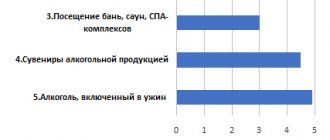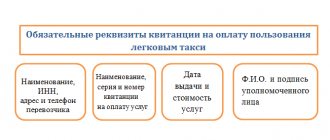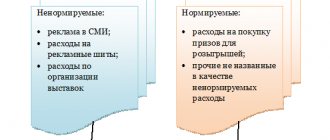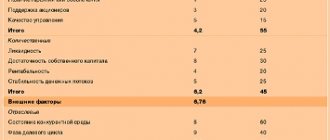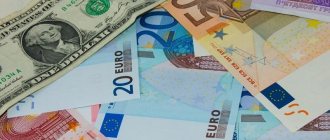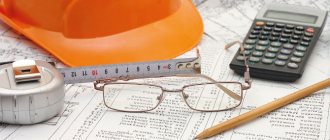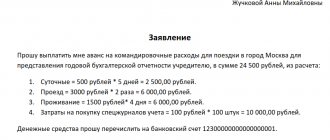Hello, Vasily Zhdanov is here, in this article we will look at business expenses. If it is customary for a company’s accounting department to keep account 44 “Sales expenses,” commercial expenses must be reflected (line 2210 of the Income Statement). Doubts, as a rule, are raised by the list of possible expenses that could be classified as commercial, since the costs of trading and manufacturing enterprises differ in composition. In addition, it is not always clear how to write off business expenses, what entries to make in the balance sheet, and how to maintain financial statements. All this will be discussed in the article.
What costs can be included in business expenses (line 2210)
Depending on whether the enterprise is a trade (wholesale, retail) or manufacturing enterprise, the list of business expenses may vary:
| Kind of activity | What are the costs involved? | additional information |
| Production | Includes any costs associated with sales: – entertainment expenses; – costs of advertising the product; – depreciation costs (wear and tear of office and commercial equipment); – payment for security services; – wages of employees (including office workers) engaged in sales; – costs of maintaining an office and warehouse space. | Any other expenses reflected in the debit of account 44 and related to distribution costs are also taken into account. |
| Trade (retail, wholesale) | Costs of selling manufactured products: – entertainment expenses aimed at promoting the product; – advertising costs; – costs of maintaining warehouses with goods ready for sale; – commission fees; – transport costs (delivery to the place where goods are sent); – packaging costs; – other similar expenses. | If we are talking about a manufacturer (processor) of agricultural products, in addition to commercial expenses include: – costs of maintaining reception and procurement points (including caring for poultry and livestock there); – general procurement costs; – other similar costs. |
The essence of economic effect and economic efficiency
Economic effect is the final economic result obtained from carrying out any event that causes an improvement in any performance indicators of the organization.
The result is an absolute indicator and is measured in monetary units. In general, obtaining an effect involves initially incurring some costs, and then receiving additional income from the implementation of the event. The economic effect itself represents this additional income, obtained through additional profits, a reduction in material and labor costs, an increase in production volumes or product quality, expressed in price. It is important to compare the result with the costs of obtaining it. Therefore, in addition to the absolute magnitude of the effect, it is necessary to know its relative magnitude. Economic efficiency is an indicator determined by the ratio of the economic effect and the costs that gave rise to this effect
Economic efficiency (E) is calculated using the formula:
Economic efficiency is an indicator determined by the ratio of the economic effect and the costs that generated this effect. Economic efficiency (E) is calculated using the formula:
(59)
Thus, efficiency determines the degree of profitability. Since this indicator is relative, it can be used for comparison either with existing standards or with other options.
In general, the profitability of implementing an event is determined by three circumstances:
1) the costs of holding the event - they should strive to be kept to a minimum;
2) the effect of implementation - it should strive for the maximum;
3) the period during which the effect is obtained.
Depending on the economic efficiency of what needs to be measured, the costs may include capital investments for the acquisition of new equipment and technologies, funds invested in a project (investment), etc.
Capital investments are funds (costs) in monetary terms that are allocated for the renewal and reproduction of the enterprise's fixed assets.
Investments are a somewhat broader concept from a financial point of view, since investments are all types of funds (costs) invested in economic activities in order to generate income.
However, in the Russian Federation it is currently customary to identify investments and capital investments.
In connection with the above, the effect will be calculated differently depending on the nature of the event that was carried out to obtain it. There is no general formula for calculating the effect. It is determined as the source of this effect is determined.
If the calculations show an annual effect from the implementation of an event, and this is usually annual, since the financial year is the time of a kind of circulation of the enterprise, then to obtain the total amount of the effect, it is multiplied by the number of years bringing this effect.
How are business expenses written off?
Enterprises are allowed to independently decide on the procedure for writing off business expenses (the rules are not approved by legislative and regulatory acts). At the same time, companies are required to consolidate the write-off method they have chosen in their accounting policies.
Important! For manufacturing companies, there are recommendations for writing off business expenses, which are given in the text of the Instructions for using the Chart of Accounts.
Product manufacturers are recommended to write off sales costs as a debit to their account. 90 “Sales” s/ac. 2 “Cost of sales”. The costs of a manufacturing company for transportation and packaging should be distributed among the varieties of shipped goods based on considerations of an independently selected indicator (cost of ready-to-sell products, volume, weight, quantity).
To calculate the amount of business expenses to be written off, you must first calculate the value of the special coefficient using the formula below:
Knowing the value of this coefficient, you can proceed to calculating the volume of business expenses of the enterprise to be written off:
What is indicated in the document being developed
The technical specifications document is a component of design or other special documentation for a product. In the absence of the latter, the specification serves as a document reflecting the full set of requirements for the product, its creation, control of production and acceptance.
The established requirements and norms cannot contain inconsistencies or contradictions with the mandatory norms of the standards developed in relation to this product, both state and interstate, operating in the territory of the Russian Federation.
The technical specifications must have a section indicating methods of quality control and acceptance of the finished product, aimed at maximizing the avoidance of disagreements between the consumer of the product and its manufacturer.
The technical specifications include an introductory part describing the general provisions for the product and the manufacturer, as well as sections that consistently reflect:
- special requirements and standards during the description of technical processes and the specifics of the manufacturing process;
- safety requirements regarding manufactured products and labor protection;
- environmental standards and regulations;
- requirements for receiving an object, methods of quality control of manufactured goods;
- standards for moving and ensuring the safety of the product;
- determination of operating parameters;
- product manufacturer's warranty terms.
As an appendix, there is an image (general view) of the product, a list of equipment (control, measuring, auxiliary), terms used and documentation, which are referenced in the specifications.
Commercial expenses are written off to (line 2210) in accounting
The following regulations and legislative acts will help you understand how to write off business expenses:
| Regulatory act, law | Application area |
| Order of the Ministry of Finance of Russia dated October 31, 2000 No. 94n | Instructions for the chart of accounts |
| Order of the Ministry of Finance of Russia dated December 28, 2001 No. 119n | Approval of Appendix 3 to the guidelines. Instructions for allocating costs for normal inventories. |
| Order of the Ministry of Agriculture of Russia dated January 31, 2003 No. 26 | Approval of appendices 3 and 4 to the guidelines. Distribution instructions for inventories that are formed in agricultural companies. |
Expenses accumulated on the account. 44, are subject to debit to the account every month. 90. But at the end of the month, this account may have a balance related to unsold finished goods (for manufacturing companies) or remaining unsold goods (for trading enterprises). The mentioned balance appears due to the distribution of transport and procurement costs, including costs for:
- procurement of agricultural raw materials, poultry and livestock (from companies engaged in agricultural production and processing);
- transportation (from trading enterprises and intermediary firms);
- packaging and transportation (from product manufacturers).
Distribution is carried out according to instructions approved by regulations listed in the table above.
What is the design of technical specifications?
The procedure for preparing technical specifications includes several stages:
- preparation of a description of the manufactured object for which development of specifications is required;
- actual development of the required conditions;
- coordination and subsequent approval of the prepared criteria;
- registration of prepared provisions (optional stage, performed if necessary).
The preparation of technical specifications begins from the moment the manufacturer makes a decision to manufacture the product according to a procedure that differs from the state standard.
To develop specifications, the following data is required:
- the product's name;
- OKPO code (for the product manufacturer);
- list of modifications of the product being developed;
- the purpose of the manufactured object and its technological description;
- OKP code (for the product);
- description of the technological production procedure indicating specific technical requirements. parameters;
- composition of components;
- procedure and criteria for the transfer/reception of goods by technical structures. manufacturer control;
- methods, means for monitoring tests in relation to the manufactured product;
- packaging methods and the material used for it, as well as a list of documents placed in containers when packing;
- types of transport used for movement and transportation parameters;
- conditions for ensuring the safety of the object;
- criteria for safety standards (during production and use of the product);
- operating parameters;
- terms for guarantee.
During the development of specifications, GOST requirements (2.114-95, 51740-2001, 2.114-2016) are used regarding the preparation of design documentation and general requirements for its preparation and execution.
How are selling expenses (line 2210) reflected in the income statement
Selling expenses of trading and manufacturing companies, which were reflected on account 90, are subject to accounting in the total cost of sales. Such costs should be reflected in line 2210 “Business expenses” in the income statement.
It also happens that an enterprise does not use account 44. This is only possible if the costs collected on the account do not have a component that is subject to mandatory distribution. If the company does not use an account. 44, business expenses are usually reflected in account 26, which is closed in 2 ways:
- By writing off the total amount of expenses accumulated by the company on account 26, directly to the debit of account 90 (then commercial expenses fall into line 2220 “Administrative expenses”).
- By including in the cost of finished goods the method of distributing the expenses collected by the company on account 26 (then the expenses are included in the amount of line 2120 “Cost of sales” in the process of writing off the cost of goods sold).
Methods for increasing the economic efficiency of enterprises
By what methods can the corresponding economic modernization of the enterprise’s activities be carried out? The calculation of the economic effect is carried out, first of all, in correlation with specific sources of innovation. What could they be?
First of all, these can be measures aimed at improving the use of resources that enterprise specialists use in their work activities. The essence of these activities may be the acquisition of new PCs, machines, robots, etc. Costs in this case may be associated with direct payment for the supply of relevant equipment, and, for example, with the organization of training for employees - that such expense items can be recorded, as we have already said above.
Activities introduced to achieve a tangible socio-economic effect may be associated with increasing the capacity of production lines so that the factory begins to need more employees. Also, the process of releasing goods can be modernized in such a way that the company will need to attract highly qualified personnel with the necessary narrow specialization to work with new technological solutions.
Personnel retraining can also be one of the methods for increasing the economic efficiency of enterprises. At the same time, it is not necessary that new equipment will be purchased: company managers can easily ensure an increase in production intensity by training specialists in innovative methods for using current capacities. Assessing the economic effect in this case involves taking into account not only the direct costs accompanying the relevant event, but also indirect ones. That is, if an enterprise sent its employees to specialized educational institutions, then in this case both the costs associated with paying for the services of these institutions and the lost profit resulting from a pause in the process of producing goods will be taken into account while specialists employed on factory lines undergo retraining.
Another option for modernizing the company’s economic activities is to improve the production structure. In this case, employees can continue to perform the same work on the same equipment, however, the mechanism characterizing product release cycles will be revised by managers. At the same time, the economic effect of the proposed measures to improve the production structure can be extremely high, since in this case the company may not have any additional costs. Managers working in it, by virtue of their job responsibilities, solve such problems. It is expected that their qualifications will be sufficient to implement the relevant plans. But it is quite possible that the company will decide to involve third-party consultants in order to ensure the necessary adjustments to the production structure. In this case, the calculation of the economic effect will be carried out taking into account the costs of paying for the services of specialists from other organizations.
Example of filling out line 2210 “Business expenses”
Let's look at an example of how line 2210 of the Income Statement is filled in:
| Indicators for s/sch 90-2 sch. 90 in correspondence with account. 44 (rubles) | ||||
| Turnover for the reporting period (2014) | Sum | |||
| 1 | 2 | |||
| 1. According to Dt s/sch 90-2 in correspondence with the account. 44 | 735 555 | |||
| Fragment of the financial results report for 2013 | ||||
| Explanations | Indicator name | Code 3 | For 2013 | For 2012 |
| 1 | 2 | 3 | 4 | 5 |
| Business expenses | 2210 | (1021) | (734) | |
Selling expenses for the reporting period amounted to 735,555 rubles.
| Fragment of the financial results report for 2013 | ||||
| Explanations | Indicator name | Code 3 | For 2014 | For 2012 |
| 1 | 2 | 3 | 4 | 5 |
| Business expenses | 2210 | (860) | (1021) | |
An example of reflecting business expenses in accounting
The following information is known about the enterprise, the main activity of which is retail trade in food and household goods:
| Business expenses item | Amount (rub.) |
| Depreciation charges (fixed assets) | 41 000 |
| Employees' wages, insurance contributions to funds | 233 000 |
| Expenses for consulting and legal services | 321 000 (including VAT RUB 44,000) |
| Costs for the delivery of goods by transport (subject to accounting as part of distribution costs, according to accounting policies) | 987 000 (including VAT RUB 135,317) |
| Rental payments for sales areas, warehouses and general business areas | 625 000 (including VAT RUB 85,687) |
| Total expenses of the enterprise for the reporting period | 3 125 000 (including VAT RUB 428,437) |
The enterprise accountant will reflect the listed expenses with the following entries:
| Accounting record | Amount (rub.) | DEBIT | CREDIT |
| Input VAT on rental costs is taken into account | 85 687 | 19 | 60 |
| Rental costs included | 539 313 (625 000 – 85 687) | 44 | 60 |
| Accepted for deduction of “input” VAT on rental costs | 85 687 | 68 | 19 |
| Input VAT on transportation costs is taken into account | 135 317 | 19 | 60 |
| The costs of transporting goods are taken into account | 851 683 (987 000 – 135 317) | 44 | 60 |
| Accepted for deduction of “input” VAT on transportation costs | 135 317 | 68 | 19 |
| Input VAT on expenses for consultations and legal services is taken into account | 44 000 | 19 | 60 |
| Costs for consultations and legal services are taken into account | 277 000 (321 000 – 44 000) | 44 | 60 |
| Accepted for deduction of “input” VAT on expenses for consultations with specialists and lawyers | 44 000 | 68 | 19 |
| Accrued wages of employees and insurance payments for wages | 233 000 | 44 | 69, 70 |
| Depreciation has been calculated on fixed assets | 41 000 | 44 | 02 |
| Total distribution costs as of the end of the reporting period | 1 941 996 (539 313 + 851 683 + 277 000 + 233 000 + 41 000) | ||
If the accountant writes off such expenses in the reporting period to account 90 “Sales” for accounting for revenue, the expenses should be reflected on line 2210 “Business expenses”. Next, in line 1210 “Inventories” (subsection “Work in Progress”) you need to indicate the amount of costs that have not been written off.
Financial analysis of management costs
Management costs in financial analysis are classified as semi-fixed, since their value does not depend on production volume. If the volume of products produced (sold) increases, profit per unit increases due to scale.
Difficult economic conditions force entrepreneurs to take a different look at the administration staffing table. Enterprise managers are trying to combine the functions of departments in order to reduce the number of employees. This allows you to reduce costs for salaries, rent, transportation, office equipment, and business trips. The amount saved is the amount of increased profit.
https://youtu.be/qcFws5r2eio
Some choose a different path - reducing wages, allowances and bonuses while maintaining the size of the administrative apparatus. This option is preferable because it does not increase the unemployment rate or reduce employee loyalty.
A good option is to transfer part of the office staff to the “home” mode, which allows saving on rent of premises, utility bills, and official transport. Almost all staff can work via the Internet.
Competent financial analysis allows you to use the optimization of administrative costs as a means of increasing profits. The funds saved on optimizing the management staff can be invested in development, reorganization, renewal, and innovation.
Top
Write your question in the form below
Answers to frequently asked questions about business expenses (line 2210)
Question: For what purpose should manufacturing companies distribute transportation and packaging costs between types of shipped products while partially writing off these costs?
Answer: Indeed, manufacturers need to do exactly this, since not all products that were shipped to customers will eventually be sold. It depends on what exactly is said in the contract between the seller and the buyer:
- if this is a supply agreement, the products are not considered sold until the buyer fully fulfills the terms of the agreement;
- if this is a goods exchange agreement, the products are not considered sold until the buyer makes a counter shipment of the goods.


